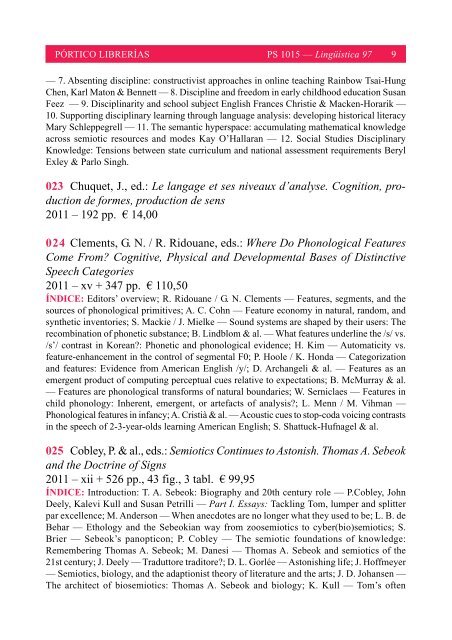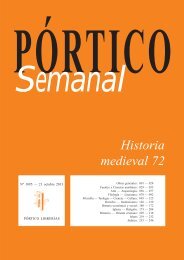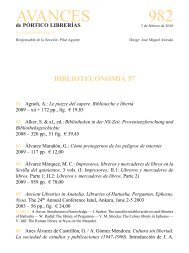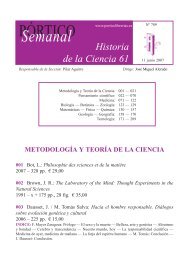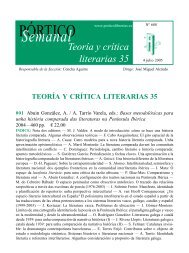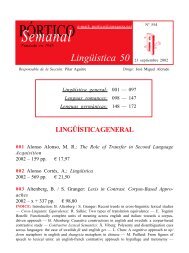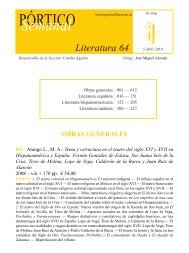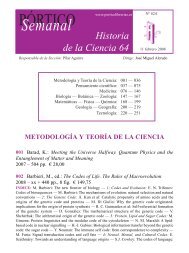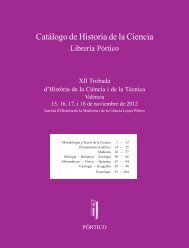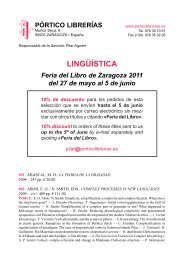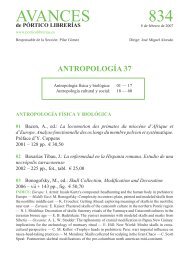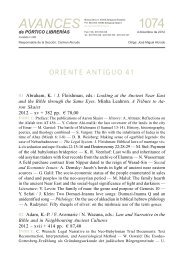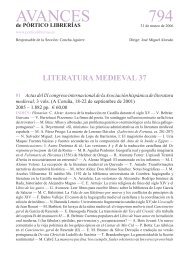Lingüística 97 - Pórtico librerías
Lingüística 97 - Pórtico librerías
Lingüística 97 - Pórtico librerías
You also want an ePaper? Increase the reach of your titles
YUMPU automatically turns print PDFs into web optimized ePapers that Google loves.
PÓRTICO LIBRERÍAS PS 1015 — <strong>Lingüística</strong> <strong>97</strong><br />
9<br />
— 7. Absenting discipline: constructivist approaches in online teaching Rainbow Tsai-Hung<br />
Chen, Karl Maton & Bennett — 8. Discipline and freedom in early childhood education Susan<br />
Feez — 9. Disciplinarity and school subject English Frances Christie & Macken-Horarik —<br />
10. Supporting disciplinary learning through language analysis: developing historical literacy<br />
Mary Schleppegrell — 11. The semantic hyperspace: accumulating mathematical knowledge<br />
across semiotic resources and modes Kay O’Hallaran — 12. Social Studies Disciplinary<br />
Knowledge: Tensions between state curriculum and national assessment requirements Beryl<br />
Exley & Parlo Singh.<br />
023 Chuquet, J., ed.: Le langage et ses niveaux d’analyse. Cognition, production<br />
de formes, production de sens<br />
2011 – 192 pp. € 14,00<br />
024 Clements, G. N. / R. Ridouane, eds.: Where Do Phonological Features<br />
Come From? Cognitive, Physical and Developmental Bases of Distinctive<br />
Speech Categories<br />
2011 – xv + 347 pp. € 110,50<br />
ÍNDICE: Editors’ overview; R. Ridouane / G. N. Clements — Features, segments, and the<br />
sources of phonological primitives; A. C. Cohn — Feature economy in natural, random, and<br />
synthetic inventories; S. Mackie / J. Mielke — Sound systems are shaped by their users: The<br />
recombination of phonetic substance; B. Lindblom & al. — What features underline the /s/ vs.<br />
/s’/ contrast in Korean?: Phonetic and phonological evidence; H. Kim — Automaticity vs.<br />
feature-enhancement in the control of segmental F0; P. Hoole / K. Honda — Categorization<br />
and features: Evidence from American English /y/; D. Archangeli & al. — Features as an<br />
emergent product of computing perceptual cues relative to expectations; B. McMurray & al.<br />
— Features are phonological transforms of natural boundaries; W. Serniclaes — Features in<br />
child phonology: Inherent, emergent, or artefacts of analysis?; L. Menn / M. Vihman —<br />
Phonological features in infancy; A. Cristià & al. — Acoustic cues to stop-coda voicing contrasts<br />
in the speech of 2-3-year-olds learning American English; S. Shattuck-Hufnagel & al.<br />
025 Cobley, P. & al., eds.: Semiotics Continues to Astonish. Thomas A. Sebeok<br />
and the Doctrine of Signs<br />
2011 – xii + 526 pp., 43 fig., 3 tabl. € 99,95<br />
ÍNDICE: Introduction: T. A. Sebeok: Biography and 20th century role — P.Cobley, John<br />
Deely, Kalevi Kull and Susan Petrilli — Part I. Essays: Tackling Tom, lumper and splitter<br />
par excellence; M. Anderson — When anecdotes are no longer what they used to be; L. B. de<br />
Behar — Ethology and the Sebeokian way from zoosemiotics to cyber(bio)semiotics; S.<br />
Brier — Sebeok’s panopticon; P. Cobley — The semiotic foundations of knowledge:<br />
Remembering Thomas A. Sebeok; M. Danesi — Thomas A. Sebeok and semiotics of the<br />
21st century; J. Deely — Traduttore traditore?; D. L. Gorlée — Astonishing life; J. Hoffmeyer<br />
— Semiotics, biology, and the adaptionist theory of literature and the arts; J. D. Johansen —<br />
The architect of biosemiotics: Thomas A. Sebeok and biology; K. Kull — Tom’s often


